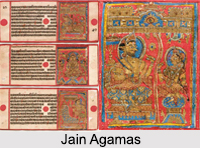 Jain Agamas are the literary works or the religious texts of Jainism. There are 46 Jain Agamas in number. Jain Agamas are revelations from Tirthankaras. In Jain tradition, Tirthankaras are considered Apta Purusha. Agama belongs to second type of Knowledge known as "Sruta Jnana" (Scriptural Knowledge) according to Jainism. The Jain Agamas describes the philosophy of Jainism. They are based on Lord Mahavira"s teachings.
Jain Agamas are the literary works or the religious texts of Jainism. There are 46 Jain Agamas in number. Jain Agamas are revelations from Tirthankaras. In Jain tradition, Tirthankaras are considered Apta Purusha. Agama belongs to second type of Knowledge known as "Sruta Jnana" (Scriptural Knowledge) according to Jainism. The Jain Agamas describes the philosophy of Jainism. They are based on Lord Mahavira"s teachings.
All religions regard the knowledge from scriptures as the "Verbal Testimony" preaching the Ultimate Truth. It is the knowledge derived from the words of a trustworthy person. A scripture is direct revelation from God through Prophet.
Etymology of Jain Agamas
Meaning of the term "Agama" states "A" as complete and "Gama" means to gain. Agama is the scripture which gives complete knowledge.
History of Jain Agamas
After the Nirvana of Lord Mahavira, the community was headed by 3 leaders known as "Arhat Kevalis". After them, the Jain community was under the leadership of 5 "Sruta Kevalis". According to Swetambara tradition, the 5 Sruta Kevalis are Prabhavaswami, Sajjambhavasuri, Yasobhadrasuri, Sambhutivijayji and Bhadrabahu I. According to Digambara tradition, the 5 Sruta Kevalis are Vishnkumara, Nandimitra, Aparajita, Govardhana and Bhadrabahu I.
During the leadership of Bhadrabahu I, there was a terrible famine in Magadha, which lasted for 12 long years. Bhadrabahu professed this famine and so he migrated to Southern India near the place called Kanara, along with Chandragupta Maurya and 12000 monks. The monks who reside in Magadha were under the leadership of Sthulabhadra. After the end of the famine, Sthulabhadra organized a meeting to compile the scriptures, as during that time scriptures were memorized and not written. Therefore it became inevitable to organize a meeting to know, exactly the content of the Agamas remembered by the surviving monks. The meeting organized for the preservation and conservation of the scripture is called as "Vacana". In all there were four Vacanas arranged, as follows:
| Council | Period | Head | Place |
| 1st | 3rd Century | Sthulabhadra | Pataliputra |
| 2nd | 4th Century | Arya Skandil | Mathura |
| 3rd | 4th Century | Nagarjunasuri | Vallabhi |
| 4th | 5th or 6th Century | Devardhigani Ksamasramana | Vallabhi |




















